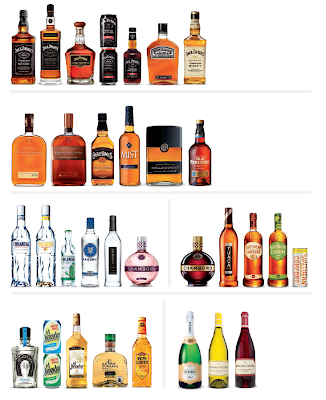Overview
Brown-Forman manufactures, bottles, imports, exports and markets a range of alcoholic beverage brands. A large chunk of its revenue comes from the Jack Daniel's line. The company produces recognizable brands for which consumers are willing to pay a premium in order to enjoy them.
The company has been paying dividends since 1949 and raising it for 29 years, making it a Dividend Aristocrat.
The Numbers
An overview of the last 10 years:For convenience, I put the most important numbers in charts:
Net sales have grown from 1,992 million to 3,784 million. An average growth rate of 7.4% during those years.
Diluted EPS has grown from $1.06 to $2.75. An average growth rate of 11.2%.
Dividends (excluded special dividends) have grown from $0.43 to $0.98 per share. An average growth rate of 8%.
Some notes:
- Outstanding shares have been steadily decreasing from 228.7 million to 215 million. This means management is returning cash to share holders through buybacks.
- As we can see, Long term debt suddenly rose from $503 million to $997 million 2012 vs 2013. This might be a red flag and something to look further into. Although, the debt to capital ratio is at 35% which isn't exceptionally high if we look at the historical debt to capital ratio.
- We can see very high profit margins, hovering in the low 20% for the last decade. Return on equity between 20% and 30% even through the Great Recession. Overall, the numbers seem pretty damn solid.
Behind the Numbers
Of course, a company is not just numbers on a piece of paper. It's a real entity, providing high quality alcoholic beverages for the consumer to enjoy. The business provides jobs to 4,000 people. It rewards its shareholders. It creates economic activity which benefits society by generating taxable income, which supports our schools, military and social programs.
Here's an overview of some of the brands Brown-Forman produces:
A look inside a Brown-Forman Cooperage company. It shows men working and making the barrels in which the Bourbons and Whisky's get distilled.
Expected Returns
Today the stock trades at around 25 times earnings. This is not sustainable in my view for the long run. Let's say that in 2023 the stock will trade at 20x earnings. Now, I have to project EPS and dividend to be able to calculate total returns. Let's look at three possible outcomes. A "normal", an optimistic and a pessimistic scenario.Normal scenario
The normal scenario: The next ten years Brown-Forman is able to perform in the same way it has for the last decade: Growing EPS at 11.2% and dividends at 8%. In 2023 the EPS would be $7.95 and along the way you would have gotten around $17.62 in dividends. Assuming you don't reinvest dividends, your total return would be 20x$7.95 + $17,62 = $176.62. Bought at today's price ($68.59) that would mean a compounded annual return of 9.9%
Optimistic scenario
The optimistic scenario:The next ten years Brown-Forman is able to perform 25% better than it has for the last decade: Growing EPS at 14% and dividends at 10%. In 2023 the EPS would be $10.19 and along the way you would have gotten around $19.98 in dividends. Assuming you don't reinvest dividends, your total return would be 20x$10.19 + $19.98 = $223.78. Bought at today's price ($68.59) that would mean a compounded annual return of 12.6%
Pessimistic scenario
The pessimistic scenario: The next ten years Brown-Forman is able to perform 25% worse than it has for the last decade: Growing EPS at 8.4% and dividends at 6%. In 2023 the EPS would be $6.16 and along the way you would have gotten around $15.55 in dividends. Assuming you don't reinvest dividends, your total return would be 20x$6.16 + $15.55 = $138.75. Bought at today's price ($68.59) that would mean a compounded annual return of 7.3%
Based on these assumptions Brown-Forman will generate between 7.3% and 12.6% shareholder returns through 2023, this is assuming you would not have reinvested dividends, if you do this, the calculated returns would be higher obviously.
Conclusion
Overall the company looks great. It holds a portfolio of great brands, it enjoys customer loyalty, high profit margins, solid growth numbers, possibility's to expand in emerging markets and international developed country's. This is a company I like to have a big stake in. To me, this company sort of resembles Coca-Cola, only with alcoholic beverages.
The company seems to be doing a good job consistently growing revenue, EPS and dividends. The company isn't very sensitive to recessions.
With quality comes a price. The stock isn't cheap right now, it trades at 25 times earnings. Based on today's fundamentals and future projections, I would pick up shares when we see it trading at $63.
Either fundamentals per share have to improve, or the market price would have to come down. I stay on the sidelines for now.
Thanks for reading





